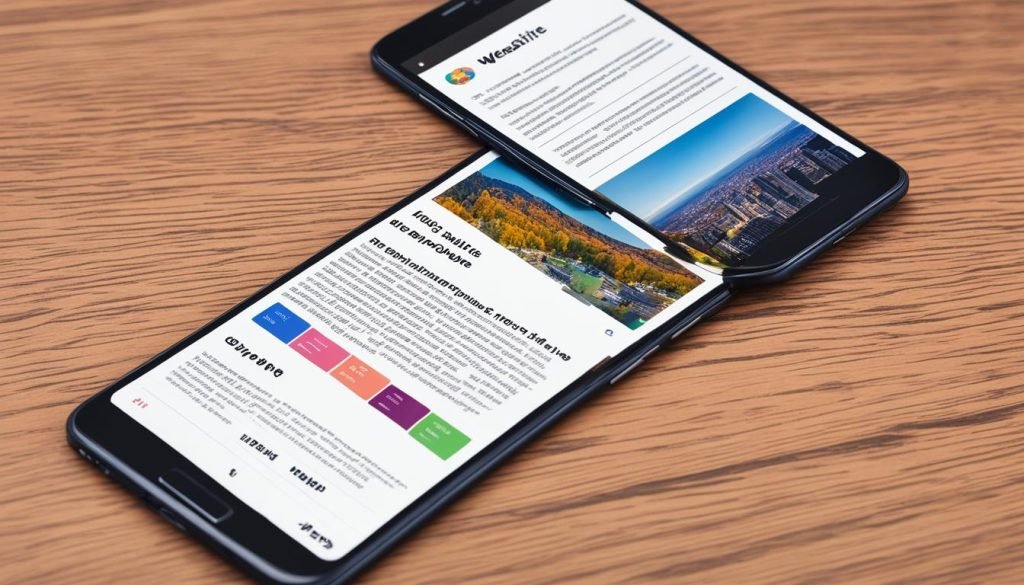Welcome to the digital era, where mobile devices have become an integral part of our daily lives. As a business owner, it’s crucial to recognize the power of mobile search engine optimization (SEO) and its impact on your online presence. With more people using their smartphones and tablets to browse the internet, it’s essential to optimize your website for mobile devices to ensure maximum visibility and reach.
Mobile SEO refers to the process of optimizing your website for mobile devices, ensuring a seamless user experience and improved search engine rankings. By partnering with a reputable mobile SEO agency, you can leverage their expertise in mobile marketing services and SEO for mobile websites to enhance your online presence and drive organic traffic to your site.
Key Takeaways:
- Mobile SEO is crucial for businesses in today’s mobile-dominated world.
- Optimizing your website for mobile devices improves user experience and search engine rankings.
- A mobile SEO agency can provide valuable expertise in mobile marketing services and SEO for mobile websites.
- Partnering with a mobile SEO agency can help drive organic traffic and increase conversions.
- Stay ahead of the competition by embracing mobile SEO strategies and maximizing your online visibility.
Why Prioritize Mobile SEO?
Mobile SEO is essential due to the dominance of mobile searches. Over 50% of global web traffic comes from mobile devices, making it crucial for businesses to optimize their websites for mobile. “Near me” searches are especially beneficial for local businesses, driving foot traffic. Mobile-friendly user experience improves search rankings and conversions. Google’s mobile-first indexing prioritizes mobile-friendly sites, meaning businesses with non-optimized websites trail behind. Prioritizing mobile SEO provides a competitive edge and builds trust and credibility with the audience.
Mobile SEO Strategy
Developing an effective mobile SEO strategy is key to optimizing your website for mobile users. Here are some best practices and tips to consider:
- Responsive Design: Implement a responsive design that adapts seamlessly to different screen sizes, ensuring a consistent user experience across devices.
- Mobile-Friendly Content: Optimize your content for mobile by using concise and easy-to-read paragraphs, headings, and bullet points.
- Page Speed Optimization: Improve your website’s load time by compressing images, enabling caching, and minimizing unnecessary code.
- Optimize Meta Titles and Descriptions: Craft compelling and concise meta titles and descriptions that capture the attention of mobile users and include relevant keywords.
- Mobile-Friendly Navigation: Ensure your website’s navigation is intuitive and easy to use on mobile devices, with clear menu options and easy access to important pages.
- Local SEO: Optimize your website for local searches by including location-specific keywords, setting up Google My Business, and getting positive online reviews.
- Continuous Monitoring and Optimization: Regularly analyze your mobile SEO performance, track relevant metrics, and make data-driven optimizations to ensure ongoing success.
Top Strategies for Mobile SEO Success
A responsive design is a key strategy for mobile SEO success, ensuring a flawless user experience across devices. It allows sites to adjust seamlessly to different screen sizes, reducing bounce rates and boosting user engagement. In addition to responsive design, there are several other strategies that optimize websites for mobile users and improve mobile SEO performance.
1. Improve Load Time
In today’s fast-paced world, mobile users expect websites to load quickly. Slow-loading websites can lead to higher bounce rates and lower conversion rates. To optimize load time:
- Optimize images by compressing them without compromising quality.
- Prioritize above-the-fold content to ensure it loads quickly.
- Enable compression to reduce file sizes.
- Eliminate unused code to streamline the website.
- Utilize a content delivery network (CDN) to serve content efficiently to users.
Improving load time enhances the user experience and positively impacts mobile SEO rankings.
2. Avoid Pop-Ups
Pop-ups can be intrusive and disrupt the user experience, particularly on mobile devices with limited screen real estate. Avoid using interstitial pop-ups that cover content, redirect users, interrupt navigation, open new windows, or require closure before accessing the page. By minimizing the use of pop-ups or using them judiciously, businesses can provide a better user experience and improve mobile SEO performance.
3. Optimize Meta Titles and Descriptions
Meta titles and descriptions are essential for improving click-through rates and mobile SEO rankings. Craft compelling, concise titles that are under 60 characters to display fully on mobile SERPs. Incorporate relevant keywords at the beginning for better visibility. Keep meta descriptions under 160 characters, using active language and including target keywords. By optimizing meta titles and descriptions, businesses can attract more clicks and improve their mobile SEO performance.
4. Use the Same URL for Mobile and Desktop
Consolidating the URL structure for mobile and desktop versions of a website is essential for mobile SEO. With Google’s mobile-first indexing, having the same URL for both versions ensures that the mobile version receives proper indexing and ranking. It also eliminates duplicate content issues that can arise from maintaining separate URLs. By using the same URL, businesses can optimize their websites for mobile users and improve their mobile SEO performance.
5. Utilize Mobile-Friendly Navigation
Mobile-friendly navigation enhances the user experience on mobile devices. Use clear menu icons or a hamburger menu that expands when clicked. Ensure that the navigation is easy to use and navigate with a thumb or finger. Implementing a sticky header or back-to-top button can also improve user experience. By employing mobile-friendly navigation, businesses provide a seamless browsing experience and enhance their mobile SEO performance.
Implementing these strategies will optimize your website for mobile users, improve their experience, and enhance your mobile SEO performance.
Go for a Responsive Design
A responsive design is a must-have for optimizing your website for both desktop and mobile devices. It ensures that your website layout adjusts seamlessly to fit any screen size, providing a smooth and engaging user experience. Google highly values user engagement, and a responsive design contributes to lower bounce rates and increased user satisfaction. Here are some quick tips to create a responsive website:
- Choose a responsive theme or template that automatically adapts to different devices.
- Arrange your content in a single column or stack to maintain readability on smaller screens.
- Make buttons large and finger-friendly, allowing easy navigation with touchscreens.
- Select an easily readable font that scales well on all devices.
- Compress images to optimize loading times without compromising quality.
Testing your website on a smartphone or tablet is essential to ensure easy navigation and an appealing appearance on mobile devices. By implementing a responsive design, you create a mobile-friendly website that enhances user experience and boosts your mobile SEO optimization.

With a responsive design, your website adapts to different screen sizes, ensuring a seamless user experience.
Improve Load Time
Mobile users often multitask or are on the go, making page load speed a crucial factor in providing a seamless mobile experience. A slow-loading website frustrates users, leading to higher bounce rates and lower conversion rates. To optimize your website for mobile users and improve mobile SEO rankings, it’s essential to focus on improving load time.
Google considers page speed as a ranking factor and favors faster-loading sites in search results. By prioritizing load time optimization, you not only enhance the user experience but also increase your visibility in mobile search. Here are some best practices to improve load time:
- Optimize images: Compress images without compromising quality to reduce file sizes and improve load speed.
- Prioritize above-the-fold content: Ensure that the most important content loads quickly, allowing users to engage with your website immediately.
- Enable compression: Use compression techniques like Gzip to reduce file sizes and accelerate website load time.
- Eliminate unused code: Remove unnecessary code, plugins, and scripts to streamline your website and improve load speed.
- Use a content delivery network (CDN): A CDN caches your website content on servers located across the globe, delivering it to users from the nearest server, reducing latency and improving load time.
By implementing these load time optimization techniques, you can provide a faster and smoother browsing experience for your mobile users, ultimately improving your mobile SEO performance.

Stay Away from Pop-Ups
Pop-ups can be frustrating for users and often lead to them leaving the website before exploring further. While pop-ups can boost conversions when used appropriately, interstitial pop-ups should be avoided. These include pop-ups that cover content, redirect users who accidentally click, interrupt navigation, open new windows, or require closure before accessing the page. By minimizing intrusive pop-ups, businesses can provide a better user experience and improve mobile SEO performance.
Pop-up ads have long been a subject of annoyance for internet users. They disrupt the browsing experience and can hinder users from accessing the desired content. When it comes to mobile websites, the negative impact of pop-ups is even more pronounced. Limited screen real estate and touch-based navigation make it harder for users to interact with pop-up elements. As a result, pop-ups on mobile websites often lead to frustration and quick exits.
Google recognizes the user frustration caused by intrusive pop-ups and has made efforts to prioritize websites that provide a better user experience. In 2017, Google introduced an algorithm update that penalized mobile sites with intrusive pop-up ads. This update emphasized the importance of mobile-friendly website optimization and mobile SEO best practices, further highlighting the need to stay away from pop-ups on mobile websites.
Common Types of Intrusive Pop-Ups to Avoid:
- Pop-ups that cover the main content of the page.
- Pop-ups that redirect users who accidentally click on the page.
- Pop-ups that interrupt navigation or obstruct finger-friendly interaction.
- Pop-ups that open new windows or tabs without user consent.
- Pop-ups that require closure before accessing the page.
Pop-ups that cover the main content of the page hinder users from accessing the information they were initially seeking. This kind of intrusive pop-up makes it difficult for users to read the content or navigate the website, leading to frustration and high bounce rates.
Redirecting users who accidentally click on the page to an unwanted destination is another form of intrusive pop-up. Users may feel deceived or irritated when they are taken to a different website or a different section of the same website against their intention.
Pop-ups that interrupt navigation or obstruct finger-friendly interaction can frustrate users and disrupt their flow. Visitors to mobile websites expect smooth and seamless browsing experiences, which can be compromised by intrusive pop-ups that get in the way of easy navigation or require precise finger taps.
Pop-ups that open new windows or tabs without user consent can be intrusive and disrupt the user’s browsing experience. Users may feel overwhelmed or annoyed when unexpected windows or tabs open up, distracting them from the content they were initially interested in.
Pop-ups that require closure before accessing the page can be a source of annoyance for users. Forcing users to close a pop-up before accessing the content they want can lead to frustration and a negative perception of the website.
By avoiding these intrusive pop-ups, businesses can provide a better mobile user experience, reduce bounce rates, and improve mobile SEO performance. Instead of relying on pop-ups, consider alternative methods to engage users, such as well-placed banners, engaging visuals, and clear call-to-action buttons. Prioritizing mobile-friendly website optimization is key to enhancing user satisfaction and achieving better mobile SEO results.
Optimize Your Meta Titles & Meta Descriptions
When it comes to mobile SEO, optimizing your meta titles and meta descriptions is essential for grabbing the attention of users in search results. These elements are the first things users see, so they need to be compelling, informative, and concise. By implementing mobile SEO best practices for meta titles and meta descriptions, you can improve your click-through rates and boost your mobile SEO rankings.
Here are some key tips to optimize your meta titles:
- Keep your meta titles under 60 characters to ensure they display fully on mobile SERPs.
- Include relevant keywords at the beginning of your meta titles.
For example, instead of “Best SEO Agency | XYZ Company,” optimize your title to say “Mobile SEO Agency | XYZ Company.”
Now, let’s focus on optimizing your meta descriptions:
- Keep your meta descriptions under 160 characters to ensure they don’t get cut off on mobile devices.
- Use active language in your meta descriptions to create a sense of urgency and encourage users to click.
- Incorporate target keywords naturally to signal to search engines what your page is about.
For instance, a well-optimized meta description could be “Looking for expert mobile SEO services? XYZ Company provides top-notch mobile marketing solutions to boost your online visibility and drive organic traffic.”
By crafting attention-grabbing and optimized meta titles and descriptions, you’ll improve your chances of attracting users and boosting your mobile SEO rankings.
Use the Same URL for Mobile & Desktop
Maintaining separate URLs for the desktop and mobile versions of your website is outdated and can lead to duplicate content issues. With Google’s mobile-first indexing, using the same URL for both versions of your website consolidates SEO value and makes it easier for search engines to index and rank your content. Having a single URL also reduces the risk of errors and allows for efficient updates and changes.
By utilizing the same URL for your mobile and desktop versions, you can optimize your website for mobile users and improve mobile SEO performance. This ensures a seamless user experience and enhances your website’s visibility in mobile search results.
Having a consistent URL across devices also simplifies the user journey, allowing for a fluid transition from mobile to desktop and vice versa. Users will no longer need to remember or bookmark different URLs, making it more convenient for them to access your website on any device.
Benefits of Using the Same URL for Mobile & Desktop:
- Consolidates SEO value
- Efficient indexing and ranking by search engines
- Reduces duplicate content issues
- Streamlines updates and changes
- Improves user experience and satisfaction
By adopting the best practice of using the same URL for your mobile and desktop versions, you can optimize your website for mobile SEO and create a seamless user experience across devices. This not only improves your search engine rankings but also increases user engagement and conversions.
| Benefits | Mobile SEO Optimization |
|---|---|
| Consolidates SEO value | By using the same URL for both mobile and desktop versions, you ensure that the SEO value of your website is consolidated and not diluted between multiple URLs. |
| Easier indexing and ranking | Search engines find it easier to crawl and index websites with a single URL, allowing your content to be ranked accurately and efficiently. |
| Reduces duplicate content | Having separate URLs for mobile and desktop versions can result in duplicate content issues, which can negatively impact your SEO efforts. Using the same URL eliminates this problem. |
| Efficient updates and changes | Maintaining a single URL simplifies the process of making updates and changes to your website. You only need to implement them once, ensuring consistency across all devices. |
| Improved user experience | A consistent URL across devices provides a seamless user experience, allowing users to switch between mobile and desktop without any hassle. |
What Is Mobile SEO?
Mobile SEO refers to optimizing websites for mobile devices to improve search engine visibility and provide a better mobile user experience. With over 60% of organic search visits coming from mobile devices, prioritizing mobile SEO is essential. It involves practices similar to traditional SEO but with a focus on mobile devices.
Google’s mobile-first indexing underscores the importance of mobile SEO, as the mobile version of a website is now the primary factor considered for rankings. Businesses must optimize their websites for mobile users to succeed in the mobile-dominated digital landscape.
“Over 60% of organic search visits come from mobile devices, surpassing desktop searches.”
- The Importance of Mobile SEO
- Mobile SEO Best Practices
- Optimizing User Experience for Mobile
| Mobile SEO Benefits | Mobile SEO Best Practices |
|---|---|
| Improved search engine visibility and rankings | Design a responsive website for seamless user experience |
| Enhanced mobile user experience | Optimize page load time for quicker access |
| Increased organic traffic and conversions | Use mobile-friendly navigation for easy site exploration |
The Importance of Mobile SEO
In today’s digital landscape, the increasing use of mobile devices for internet browsing has made mobile SEO a crucial aspect of any successful online strategy. With over 60% of organic search visits coming from mobile devices, surpassing desktop searches, optimizing your website for mobile users is no longer an option but a necessity.
Google’s mobile-first indexing further emphasizes the significance of mobile optimization. By prioritizing mobile versions of websites, search engines prioritize websites that are optimized for mobile devices. Ignoring mobile SEO can lead to missed opportunities and lower visibility in search engine rankings.
As users increasingly rely on their smartphones for various online activities, providing a seamless user experience on mobile devices is essential. Mobile SEO ensures that your website is responsive, fast-loading, and user-friendly, enhancing the overall user experience and driving organic traffic.
By implementing effective mobile SEO strategies, you can improve your website’s search engine rankings, increase organic traffic, and ultimately boost conversions. Don’t miss out on the potential benefits that mobile SEO can bring to your business.
3 Ways to Configure Your Website for Mobile
When it comes to optimizing your website for mobile devices, there are three different options to consider: responsive design, dynamic serving, and separate URLs. Out of these three, responsive design is highly recommended as it ensures a consistent and seamless user experience across all devices.
Responsive design is a mobile-friendly website optimization technique that allows your website to adapt and adjust its layout based on the user’s device screen size. By using responsive design, your website will automatically resize and reposition elements to fit perfectly on mobile screens, making it easier for your audience to navigate and engage with your content.
On the other hand, dynamic serving involves displaying different HTML to users based on their device, which can be more complex to implement and maintain. Separate URLs, another option, create different versions of your website specifically for mobile and desktop users. However, this approach can lead to duplicate content issues and is not recommended by Google.
By choosing a mobile-friendly responsive design, you can optimize your website for mobile users and enhance your mobile SEO performance. A user-friendly and visually appealing mobile website will not only attract and retain visitors but also improve your search engine rankings, driving organic traffic and boosting conversions.
Looking For Affordable Web Design and Digital Marketing?
AM Web Design and Digital Marketing provides professional web design services at a price that you can afford. If you have any questions or want to know more about how we can help your business grow, contact us today on 0191 5111009.
You can check out our reviews on our Google Business Profile and see why we would be the right choice for you.



